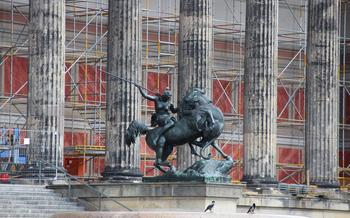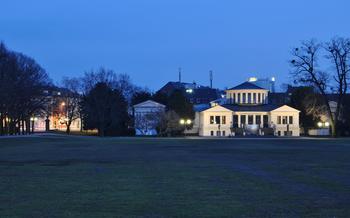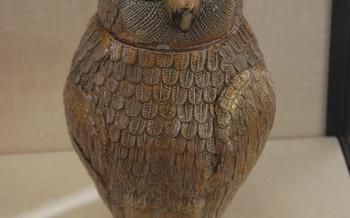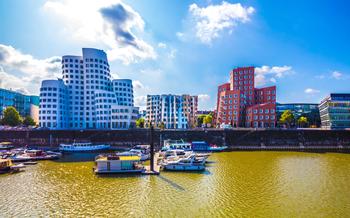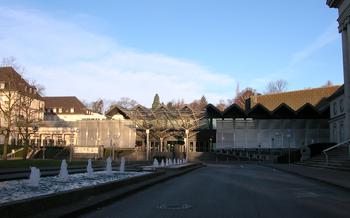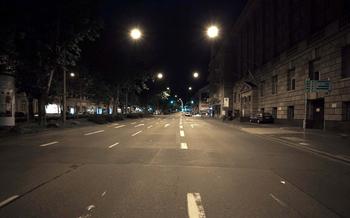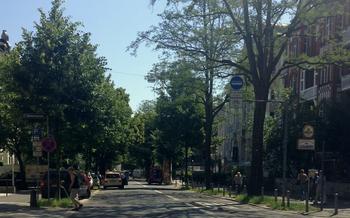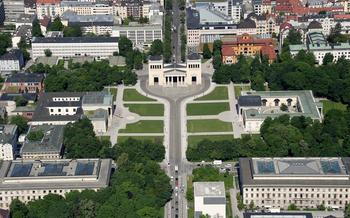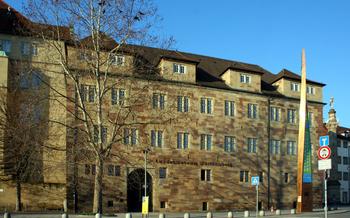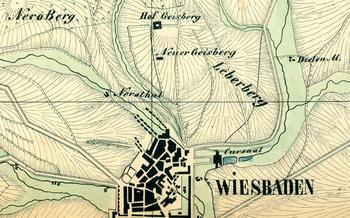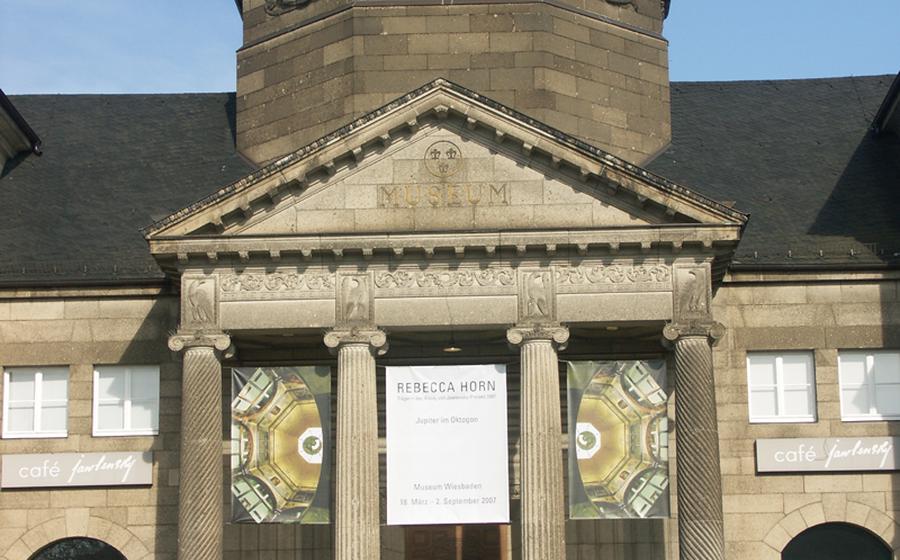
Landesmuseum Wiesbaden
- The Landesmuseum Wiesbaden: A Cultural Gem
- Exploring the Museum's Rich Collections
- Ancient Egyptian Collection
- Greek and Roman Antiquities
- Medieval and Renaissance Art
- Modern and Contemporary Art
- Special Exhibitions and Events
- Interactive Exhibits and Activities
- Educational Programs and Workshops
- The Museum's Library and Archives
- The Museum's Café and Shop
- Accessibility and Amenities
- Planning Your Visit
- Getting to the Landesmuseum Wiesbaden
- Insider Tip: Hidden Gems of the Museum
The Landesmuseum Wiesbaden: A Cultural Gem
The Landesmuseum Wiesbaden is a treasure trove of art and history, nestled in the heart of the Hessian capital. Founded in 1825, it is one of the oldest and most respected museums in Germany. The museum's impressive neoclassical building, designed by renowned architect Philipp Hoffmann, is a sight to behold, with its grand columns and intricate facade.
The Landesmuseum Wiesbaden boasts a diverse collection spanning various eras and cultures. From ancient Egyptian artifacts to Greek and Roman sculptures, medieval masterpieces to modern and contemporary art, the museum offers a journey through time and creativity. Its rich holdings have made it a renowned institution, attracting visitors from around the world.
With its central location on Friedrich-Ebert-Allee, the museum is easily accessible by foot, public transportation, or car. Whether you're an art enthusiast, a history buff, or simply looking for a unique cultural experience, the Landesmuseum Wiesbaden promises an enriching visit.
Exploring the Museum's Rich Collections
The Landesmuseum Wiesbaden boasts a diverse array of collections that span various cultures and historical periods. Visitors can embark on a journey through time, beginning with the ancient Egyptian artifacts that provide a glimpse into the civilization's rich history. Among the highlights are intricately carved statues, mummies, and sarcophagi, offering insights into the beliefs, rituals, and daily life of the ancient Egyptians.
The museum also houses a remarkable collection of Greek and Roman antiquities, showcasing the influence of classical art on Western civilization. Notable sculptures and statues depict mythological figures, gods, and heroes, providing a glimpse into the ancient world's religious beliefs and cultural exchange.
For those interested in the Middle Ages and Renaissance, the museum's collection features masterpieces from this era. Paintings, sculptures, and tapestries adorned with intricate details and symbolism showcase the artistic achievements and religious themes of the time. Visitors can admire the works of renowned artists, gaining an understanding of the artistic techniques and styles that shaped this period.
The museum's modern and contemporary art collection features works from the 19th and 20th centuries, highlighting the diverse artistic movements and expressions of the modern era. Notable pieces include paintings, sculptures, installations, and performance art that reflect the social and political themes of the time.
Ancient Egyptian Collection
The Landesmuseum Wiesbaden boasts an impressive collection of ancient Egyptian artifacts, offering visitors a glimpse into the rich history and culture of this ancient civilization. Among the highlights of the collection are the intricately carved statues and reliefs depicting Egyptian gods and goddesses, such as the majestic statue of Sekhmet, the goddess of war and healing. The museum also houses a significant collection of mummies and sarcophagi, providing a fascinating insight into ancient Egyptian burial practices and beliefs in the afterlife.
The collection includes a variety of objects that shed light on daily life in ancient Egypt, such as tools, pottery, and jewelry. Visitors can admire the intricate craftsmanship of the ancient Egyptians as they explore the collection of amulets, scarabs, and other personal items. The museum also features a reconstruction of an ancient Egyptian tomb, allowing visitors to experience the burial chamber of an Egyptian pharaoh or noble.
Greek and Roman Antiquities
The Landesmuseum Wiesbaden boasts an impressive collection of Greek and Roman antiquities, offering a glimpse into the rich cultural heritage of the ancient world. Among the notable highlights are the exquisite sculptures and statues that showcase the remarkable artistry and craftsmanship of these ancient civilizations.
Notable Sculptures and Statues:
-
Apollo of Cyrene: This stunning marble statue depicts the Greek god Apollo, standing tall and majestic. The intricate details and lifelike features of the sculpture are a testament to the skill and artistry of the ancient Greek sculptors.
-
Head of Zeus: A fragment of a larger-than-life statue, the Head of Zeus exudes an aura of power and divinity. The commanding presence and serene expression of the god are captured with remarkable precision.
-
Dancing Maenad: This dynamic sculpture portrays a Maenad, a follower of the Greek god Dionysus, engaged in a wild and ecstatic dance. The swirling drapery and expressive body language convey the fervor and energy of the ancient religious rituals.
Influence of Classical Art:
The Greek and Roman antiquities at the Landesmuseum Wiesbaden demonstrate the profound influence of classical art on Western culture. The sculptures, with their emphasis on realism, proportion, and anatomy, served as models for later artists and continue to inspire contemporary artistic expression.
Mythology and Religious Beliefs:
The collection provides valuable insights into the mythology and religious beliefs of ancient Greece and Rome. The depictions of gods, goddesses, and mythological creatures offer a glimpse into the rich tapestry of stories and legends that shaped these ancient cultures.
Trade and Cultural Exchange:
The presence of Greek and Roman artifacts in Wiesbaden reflects the extensive trade and cultural exchange that took place throughout the ancient world. The movement of goods, ideas, and artistic influences contributed to the development of a shared cultural heritage across the Mediterranean region.
Medieval and Renaissance Art
The Landesmuseum Wiesbaden boasts an impressive collection of medieval and Renaissance art, offering a glimpse into the artistic and cultural achievements of these transformative eras. Masterpieces from the Middle Ages include intricately carved wooden sculptures, vibrant paintings depicting religious scenes, and finely woven tapestries that tell stories of chivalry and romance.
Religious themes and iconography dominate this section of the museum, with altarpieces, triptychs, and devotional paintings showcasing the skill and artistry of medieval craftsmen. The museum's collection also features exquisite examples of Renaissance art, with paintings by Italian masters such as Botticelli and Raphael, as well as German and Dutch artists of the period.
Visitors can admire the meticulous attention to detail in the paintings, the delicate brushwork, and the use of vibrant colors. The works of art provide insights into the religious beliefs, social customs, and cultural values of the time, offering a fascinating glimpse into the minds and hearts of people who lived centuries ago.
The museum's medieval and Renaissance collection is a testament to the enduring legacy of these artistic periods, preserving and showcasing the remarkable creativity and craftsmanship that shaped the cultural landscape of Europe for centuries.
Modern and Contemporary Art
The Landesmuseum Wiesbaden boasts an impressive collection of modern and contemporary art, showcasing masterpieces from the 19th and 20th centuries. Visitors can admire works from various artistic movements, including Expressionism, Cubism, and Surrealism.
Expressionist Paintings: Immerse yourself in the vibrant colors and emotional intensity of Expressionist paintings. The museum features works by prominent artists such as Ernst Ludwig Kirchner and Erich Heckel, who sought to express their inner feelings and subjective experiences through bold brushstrokes and distorted forms.
Cubist Masterpieces: Discover the groundbreaking techniques of Cubism, where artists like Pablo Picasso and Georges Braque deconstructed and rearranged forms to create a new visual language. See how they shattered objects into geometric shapes, creating multiple perspectives and challenging traditional notions of representation.
Surrealist Wonders: Step into the imaginative world of Surrealism, where artists explored the subconscious mind and the realms of dreams. Discover works by Salvador Dalí, René Magritte, and Max Ernst, who used fantastical imagery, symbolism, and unexpected juxtapositions to create thought-provoking and dreamlike compositions.
Installations and Performance Art: Experience the cutting-edge world of contemporary art, where installations and performance art challenge traditional notions of artistic expression. Engage with interactive exhibits that invite you to participate and explore the boundaries between art and reality.
Special Exhibitions and Events
The Landesmuseum Wiesbaden regularly hosts temporary exhibitions that showcase a wide range of art and artifacts from around the world. These exhibitions often focus on specific themes, artists, or historical periods, providing visitors with an in-depth look at a particular subject.
In addition to temporary exhibitions, the museum also offers a variety of lectures, workshops, and guided tours. These events are led by experts in their respective fields and provide visitors with an opportunity to learn more about the museum's collections, the history of art, and the latest developments in the art world.
The museum also hosts a number of educational programs and cultural events throughout the year. These programs are designed for visitors of all ages and include art classes, workshops, lectures, and seminars. The museum also hosts a variety of cultural events, such as concerts, film screenings, and festivals, that celebrate the diversity of human creativity and expression.
Interactive Exhibits and Activities
The Landesmuseum Wiesbaden offers a range of interactive exhibits and activities designed to engage visitors of all ages. These innovative displays and experiences bring the museum's collections to life and provide a deeper understanding of the diverse cultures and historical periods represented.
Visitors can immerse themselves in ancient Egyptian culture through hands-on activities that allow them to decipher hieroglyphs, explore the construction of pyramids, and virtually navigate through a tomb. Multimedia presentations showcase the latest research and discoveries in archaeology and art history, providing insights into the lives and beliefs of past civilizations.
The museum also embraces technology to enhance the visitor experience. Virtual reality and augmented reality experiences transport visitors back in time, allowing them to explore ancient cities, witness historical events, and interact with virtual artifacts. Educational games and quizzes challenge visitors to test their knowledge and engage with the museum's collections in a fun and interactive way.
Educational Programs and Workshops
The Landesmuseum Wiesbaden offers a wide range of educational programs and workshops designed to engage visitors of all ages and interests. School groups can take advantage of guided tours and interactive workshops tailored to their curriculum, covering topics from ancient Egypt to modern art. Families can participate in hands-on activities, storytelling sessions, and art-making workshops that encourage creativity and exploration.
Art enthusiasts can enhance their knowledge and skills through specialized classes and workshops led by experienced artists and educators. These workshops cover various mediums, techniques, and artistic styles, providing participants with the opportunity to learn from experts and create their own works of art.
The museum also organizes lectures, seminars, and symposiums on art history, archaeology, and related topics. These events feature renowned scholars, curators, and artists who share their insights and expertise, fostering a deeper understanding and appreciation of the museum's collections.
Additionally, the museum's research facilities and extensive library are open to scholars and researchers, providing access to a wealth of resources for academic study and research projects.
The Museum's Library and Archives
The Landesmuseum Wiesbaden houses a comprehensive library and archive that serves as a valuable resource for scholars, researchers, and visitors alike. With an extensive collection of books, manuscripts, documents, and photographs, the library offers a wealth of information on art, history, and culture. The archives, on the other hand, preserve a rich collection of historical records, such as letters, diaries, and administrative documents, providing insights into the museum's past and the history of Wiesbaden.
The library's collection boasts over 100,000 volumes, including rare and valuable books on art history, archaeology, and related fields. Researchers can access a wide range of publications, from scholarly monographs and exhibition catalogs to periodicals and newspapers. The library also houses a collection of specialized reference works, such as encyclopedias, dictionaries, and bibliographies, which assist researchers in their studies.
The museum's archives contain a treasure trove of historical documents that shed light on the development of the museum and the city of Wiesbaden. Visitors can explore letters, diaries, and administrative records that document the museum's founding, its acquisitions, and its exhibitions. The archives also preserve personal papers and correspondence of prominent figures associated with the museum, offering insights into their lives and contributions.
Furthermore, the library and archives actively engage in digitization projects to make their collections more accessible to a global audience. Through online databases and digital repositories, researchers and enthusiasts from around the world can access and explore the museum's vast resources, fostering knowledge sharing and promoting scholarly research.
The Museum's Café and Shop
After exploring the museum's vast collection, visitors can relax and recharge at the cozy café. With its panoramic views of the city and the surrounding hills, the café offers a delightful setting to enjoy a refreshing beverage or a light meal. The menu features a variety of snacks, sandwiches, and pastries, as well as specialty coffees and teas.
The museum shop is a treasure trove of unique souvenirs and gifts. Here, visitors can find a wide selection of books, postcards, and art prints featuring the museum's collection. There are also a variety of gift items, such as jewelry, scarves, and home décor, inspired by the museum's exhibits. Whether you're looking for a memento of your visit or a special gift for someone back home, the museum shop is sure to have something to suit your taste.
Accessibility and Amenities
The Landesmuseum Wiesbaden is committed to providing a welcoming and accessible environment for all visitors. The entire museum is wheelchair accessible, with ramps, elevators, and wide corridors. Audio guides and tours are available in multiple languages, including English, German, French, and Spanish. The museum also offers a variety of family-friendly facilities, such as changing tables, nursing rooms, and a children's play area. Lockers and storage facilities are available for visitors to store their belongings while they explore the museum.
Planning Your Visit
Before embarking on your journey to the Landesmuseum Wiesbaden, it is essential to plan your visit to make the most of your experience. The museum is open from Tuesday to Sunday, with extended hours on Thursdays. Admission fees vary depending on the type of ticket and any special exhibitions. Guided tours are available in multiple languages and can be booked in advance to ensure a more immersive and informative experience.
To avoid the crowds and enjoy a more tranquil visit, consider visiting the museum during the weekdays, particularly in the morning hours. Photography is permitted within the museum, but flash photography and tripods are not allowed. Visitors are encouraged to share their experiences and favorite exhibits on social media using the designated hashtags.
Getting to the Landesmuseum Wiesbaden
The Landesmuseum Wiesbaden is conveniently located in the heart of the city, making it easily accessible by public transportation. Several bus and tram lines stop nearby, and the Wiesbaden Hauptbahnhof (main train station) is just a short walk away. For those arriving by car, there are several parking garages and lots in the vicinity. The museum also offers bike racks for cyclists.
Once you arrive at the museum, be sure to take some time to explore the surrounding area. The museum is situated in the Kulturpark Wiesbaden, a beautiful park that is home to several other cultural institutions, including the Hessian State Theater and the Museum Wiesbaden. The park also offers a variety of recreational activities, such as walking, jogging, and biking.
Insider Tip: Hidden Gems of the Museum
Beyond the well-known exhibits, the Landesmuseum Wiesbaden holds secret passageways and hidden rooms that offer a glimpse into the museum's rich history and forgotten treasures. One such hidden gem is the "Secret Room," which houses a collection of rare and unusual artifacts, including a 16th-century astrolabe, a fossilized dinosaur egg, and a mysterious Egyptian amulet.
Another hidden treasure is the "Curator's Choice" exhibition, which showcases lesser-known masterpieces and overlooked exhibits from the museum's vast collection. Here, visitors can discover forgotten paintings, sculptures, and artifacts that shed light on the museum's diverse history and curatorial practices.
To uncover these hidden gems, visitors can embark on a self-guided exploration or join a guided tour that delves into the museum's secret corners and forgotten stories. These tours offer unique perspectives and vantage points, allowing visitors to experience the museum in a new and unforgettable way.
